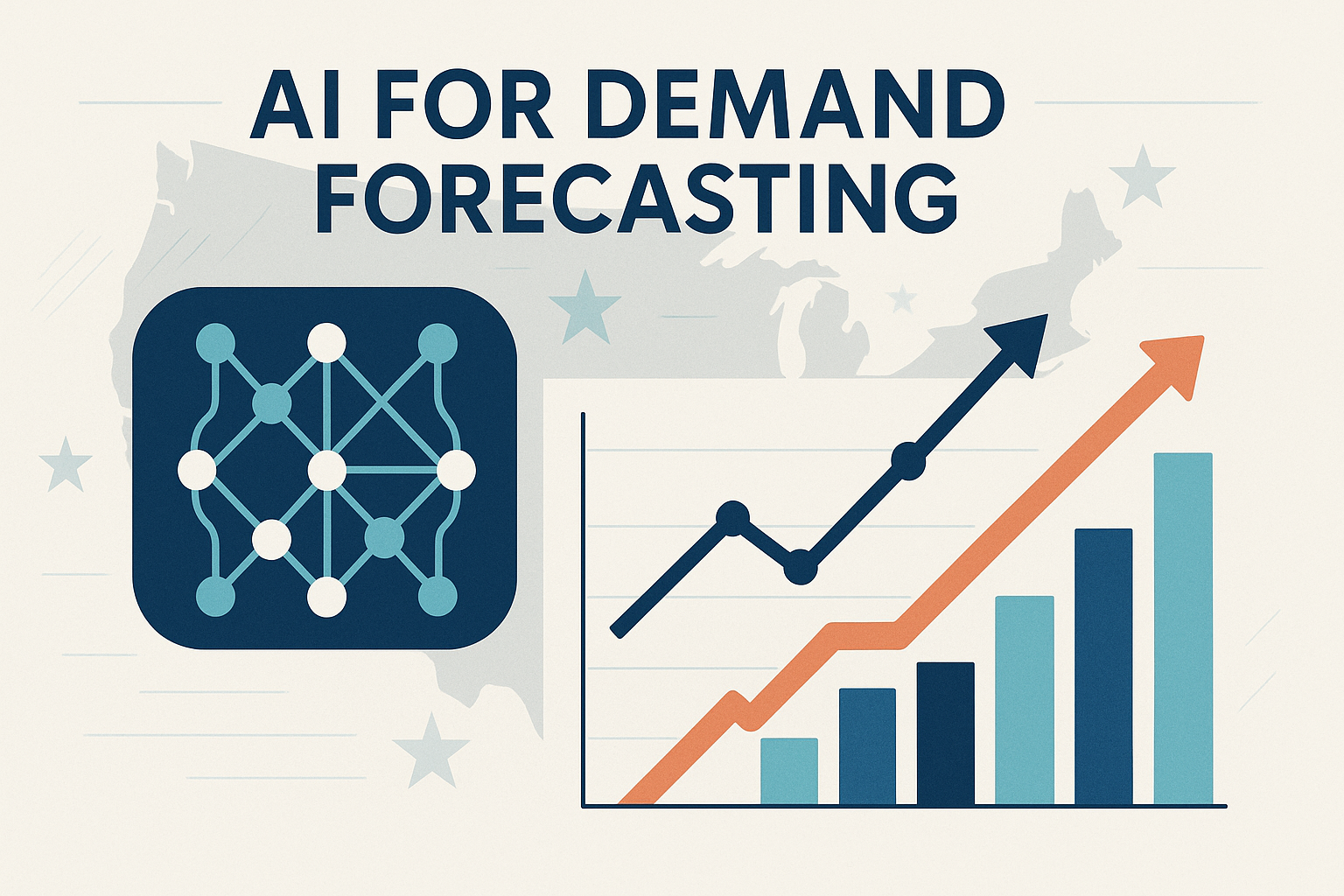
AI for Demand Forecasting: The Ultimate 2025 Guide for U.S. Businesses
In 2025, AI for demand forecasting is revolutionizing how U.S. companies predict customer needs, optimize inventory, and maximize profits. Whether you’re in retail, manufacturing, or logistics, leveraging artificial intelligence for demand forecasting can give your business a competitive edge. This comprehensive guide explores the latest trends, benefits, and best practices for implementing AI-driven demand forecasting in the United States.
What Is AI for Demand Forecasting?
AI for demand forecasting refers to the use of artificial intelligence algorithms and machine learning models to predict future customer demand for products or services. Unlike traditional forecasting methods, AI can analyze vast amounts of historical data, identify complex patterns, and adapt to changing market conditions in real time.
How Does AI Improve Demand Forecasting?
- 📊 Big Data Analysis: AI processes large datasets from multiple sources (sales, weather, social trends).
- 🤖 Pattern Recognition: Machine learning detects hidden trends and seasonality.
- 🔄 Continuous Learning: Models improve accuracy as new data becomes available.
- ⏱️ Real-Time Updates: AI provides up-to-date forecasts for agile decision-making.
TIP: Integrate AI with your existing ERP or inventory management systems for seamless forecasting and automation.
Why U.S. Companies Are Adopting AI for Demand Forecasting in 2025
The U.S. market is highly dynamic, with consumer preferences shifting rapidly. In 2025, businesses face challenges like supply chain disruptions, inflation, and evolving e-commerce trends. AI-powered demand forecasting helps companies:
- 📦 Reduce Stockouts and Overstocks: Maintain optimal inventory levels.
- 💰 Increase Profit Margins: Minimize waste and markdowns.
- 🚚 Enhance Supply Chain Efficiency: Improve planning and logistics.
- 🏆 Stay Competitive: Respond faster to market changes.
Top 10 AI Tools for Demand Forecasting in the U.S. (2025)
Choosing the right AI solution is crucial. Here’s a ranked list of the top 10 AI tools for demand forecasting, tailored for U.S. businesses in 2025:
- Microsoft Dynamics 365 AI
- SAP Integrated Business Planning (IBP)
- Oracle Demand Management Cloud
- Amazon Forecast
- Blue Yonder (formerly JDA)
- Infor Demand Management
- Kinaxis RapidResponse
- o9 Solutions
- ToolsGroup SO99+
- NetSuite Demand Planning
Side-by-Side Comparison Table
| Rank | Tool Name | Key Features | Best For | AI Capabilities |
|---|---|---|---|---|
| 1 | Microsoft Dynamics 365 AI | End-to-end integration, cloud | Enterprises, Retail | Advanced ML, NLP |
| 2 | SAP IBP | Real-time analytics | Manufacturing, Pharma | Predictive Analytics |
| 3 | Oracle Demand Management Cloud | Scalable, customizable | Large Enterprises | Deep Learning |
| 4 | Amazon Forecast | Easy AWS integration | E-commerce, SMBs | Automated ML |
| 5 | Blue Yonder | Supply chain focus | Retail, Logistics | AI Optimization |
| 6 | Infor Demand Management | Industry-specific modules | Manufacturing, Distribution | ML Forecasting |
| 7 | Kinaxis RapidResponse | Scenario planning | Supply Chain, Automotive | Real-time AI |
| 8 | o9 Solutions | Integrated planning | CPG, Retail | AI/ML Modeling |
| 9 | ToolsGroup SO99+ | Inventory optimization | Wholesale, Retail | ML Algorithms |
| 10 | NetSuite Demand Planning | ERP integration | SMBs, E-commerce | Basic AI Forecasting |
TIP: When selecting an AI tool, consider your business size, industry, and integration needs for maximum ROI.
Key Benefits of AI for Demand Forecasting in 2025
1. Improved Forecast Accuracy
✅ AI models reduce human error and bias, delivering more precise forecasts.
2. Faster Response to Market Changes
✅ Real-time data processing allows businesses to adapt quickly to demand fluctuations.
3. Enhanced Customer Satisfaction
✅ Accurate forecasts mean products are available when and where customers want them.
4. Cost Savings
✅ Lower inventory holding costs and reduced markdowns boost profitability.
5. Scalability
✅ AI solutions grow with your business, handling increased data and complexity.
How to Implement AI for Demand Forecasting: Step-by-Step Guide
Step 1: Assess Your Data
- Gather historical sales, inventory, and external data (weather, promotions).
- Ensure data quality and consistency.
Step 2: Choose the Right AI Tool
- Evaluate features, scalability, and integration capabilities.
- Consider industry-specific solutions.
Step 3: Train and Test AI Models
- Use historical data to train machine learning models.
- Validate accuracy with test datasets.
Step 4: Integrate with Business Systems
- Connect AI forecasts to ERP, CRM, and supply chain platforms.
- Automate inventory and procurement decisions.
Step 5: Monitor and Refine
- Continuously monitor performance.
- Retrain models as new data becomes available.
TIP: Start with a pilot project before scaling AI demand forecasting across your organization.
Real-World Use Cases: AI for Demand Forecasting in the U.S.
Retail
🏬 Major U.S. retailers use AI to predict seasonal demand, optimize promotions, and reduce excess inventory.
Manufacturing
🏭 Manufacturers leverage AI to align production schedules with market demand, minimizing waste.
E-commerce
🛒 Online stores use AI to forecast product trends, manage flash sales, and improve fulfillment rates.
Logistics
🚚 Logistics providers apply AI to anticipate shipping volumes and allocate resources efficiently.
Common Challenges and How to Overcome Them
- Data Silos: Integrate data from all departments for holistic forecasting.
- Change Management: Train staff and foster a data-driven culture.
- Model Complexity: Start simple and gradually adopt advanced AI features.
TIP: Partner with AI experts or consultants to accelerate your demand forecasting transformation.
Conclusion: Why AI for Demand Forecasting Is Essential for U.S. Businesses in 2025
In 2025, AI for demand forecasting is no longer a luxury—it’s a necessity for U.S. businesses aiming to thrive in a fast-paced, unpredictable market. By harnessing the power of artificial intelligence, companies can achieve unprecedented forecast accuracy, reduce costs, and delight customers with better product availability. The top AI tools offer scalable, industry-specific solutions that integrate seamlessly with existing systems. To succeed, focus on high-quality data, choose the right technology, and foster a culture of innovation. Embrace AI-driven demand forecasting today to future-proof your business and stay ahead of the competition.